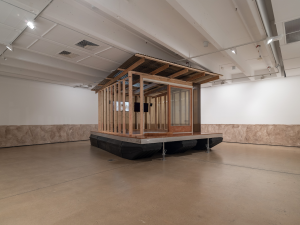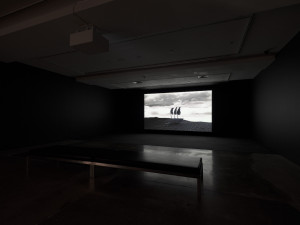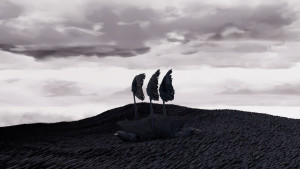Empire overboard
Jocelyn Flynn
Published September 2024
The tidal current runs to and fro in its unceasing service, crowded with memories of men and ships it had borne to the rest of home or to the battles of the sea…It had borne all the ships whose names are like jewels flashing in the night of time…What greatness had not floated on the ebb of that river into the mystery of an unknown earth! The dream of men, the seed of commonwealths, the germs of empires.1
The world as we know it is built on ships and we are drowning in its wake. The names of such ships pervade our history — the Endeavour, Victoria, Alexander, Mayflower, Windrush. They take up a position in the colonial imaginary pertaining to discovery, wealth and power. In their sails that billowed towards this Continent were the ideals of Western humanism that arose in the European Age of Discovery, and power structures that focus wealth and prosperity of the empire at the expense of people, land, and sea. Those sails heralded the current settler-colonial order in so-called Australia, and brought in the Anthropocene, Plantationcene, and Capitalocene among others — all symptoms of the dregs of empire.2
Joseph Conrad’s Heart of Darkness, a novella famous for its critique of imperialism but by the same stroke also perpetuates ideas of the Majority World as the ‘foil to Europe’,3 begins on the River Thames, the seat of the empire that ruptured this Continent. Directed from that river, the ‘ships whose names are like jewels’ symbolise their glory and hold in the imperial imaginary that is unchecked. From the Maiwar, the river that I now call home as a settler on Turrbal and Yuggera lands, a strong response to this symbolism took form at the Institute of Modern Art (IMA) in April 2024, near to the bend in the river known as Magandjin/Meanjin.4 Jasmine Togo-Brisby’s solo exhibition It Is Not A Place, and Sarah Poulgrain’s Houseboat (gallery side), offer a counter-narrative to the ships that represent Western thalassocracy. Calling in a future that remembers the past and centers collective action, Togo-Brisby and Poulgrain’s vessels envision a new maritime order.
It Is Not A Place
Christina Sharpe writes of the eternal aftermath of slavery as being ‘in the wake.’ She says, “in the wake, the past that is not the past reappears, always, to rupture the present”.5 Jasmine Togo-Brisby’s practice allows submerged histories to come to the surface, making visible the stories of her family entangled with histories of slavery as Australian South Sea Islanders. In her practice, Togo-Brisby unravels ‘the past that is not the past’ being kin of displaced Ancestors in the colony.
In her solo exhibition, a video work of the same title, It Is Not a Place 2024 is a haunting and nauseating animation of a pitching ship in the ocean. The ship and the ocean it sails on, is not a visual that inspires maritime power, but rather elicits the horror of it as the sea and ship are made from crow feathers, where little differentiates one from the other. There is no beginning nor end to the film, the ceaseless movement and the uncertainty of the destination, if there even is one, grows larger with each moment the video progresses. It evokes a sense of the encompassing feeling endured by the artist’s Ancestors, of being neither here — in the colony — nor there — at home — and for the artist now, of being in the past and present at the same time.
It Is Not a Place visually depicts ships as the harbingers of chaos, existing in a liminal seascape that carried with it world orders that relegated long standing land and sea-based knowledge systems. Togo-Brisby’s ship is frustratingly persistent in its voyage, much like the way in which these ships in history came and went but the colonial mentality and the values of empire it represented remained, disrupting and displacing subjugated bodies and knowledge in its wake. Togo-Brisby’s video is a lament to her people disrupted by these ships, countering their power with an image that solemnly holds the history and memories of Ancestors.
Houseboat (gallery side)
Another vessel holds its place within the walls of the IMA in a separate exhibition entitled Platform. Against the expectation of white walls, the vessel sits in a room with a low brown horizon, overtly recognisable for anyone who lives in a flood zone, as the artist Sarah Poulgrain does. The vessel, Houseboat (gallery side) 2024 is half the realisation of the artist’s goal to design, build, live in, and display art, an adaptive version of the current space they live in and run, Wreckers Artspace in Woolloongabba. The work responds to the conditions they contend with working in the arts in a time of increasing living costs and climate events. As a remedy to the current order that harbours individualism and capital gain, Poulgrain levels structures of knowledge acquisition by learning, skill-sharing and collaborating with a myriad of people who share the goal of reimagining their collective futures by developing community-driven responses to current conditions.
Houseboat is not designed to attack the waters of the world but rather be a vessel that thrives in its intended purpose as a living and exhibition space. As such, the vessel is inviting, with the design being drafted by collaborator Marilena Hewitt. On display inside the gallery vessel is a handmade rug by Leen Rieth placed at its entrance alongside Alrey Batol’s rocket stove and alcohol burners, and with Charlie Hillhouse’s two-channel video that shows its actual build. Poulgrain hopes to one day launch the vessel on the Maiwar, where it can float with the tides of the river, rather than be collateral damage in its ever-flooding path.
The many hands and minds that came together to bring this work to fruition is a testament to the value of community and skill-sharing in a time where access to crucial resources is becoming more fraught with the changing socio-political and environmental climate. As a counter to the ships that brought this Continent into our uneasy present, Houseboat (gallery side) is the courageous vessel that envisions a passage against this reality.
In tandem, Togo-Brisby’s It Is Not A Place and Poulgrain’s Houseboat (gallery side) push back on the idea of ships as symbols of uncontested power, challenging notions of empire and its values and ideals that were carried by ships across waters. Their vessels are a signal of a future of empire fading below the horizon, where we lament what has occurred and work together for what lies ahead.
Joseph Conrad, Heart of Darkness (London: Penguin Books, 1995), 49.
Heather Davis, and Zoe Todd. “On the Importance of a Date, or Decolonizing the Anthropocene.” ACME an International E-Journal for Critical Geographies 16, no. 4 (2017): 774.
Chinua Achebe, “An Image of Africa: Racism in Conrad’s Heart of Darkness,” The Massachusetts Review; Amherst 57, no.1 (Spring 2016): 15 https://doi.org/10.1353/mar.2016.0003
Gaja Kerry Charlton, “Makunschan, Meeanjan, Miganchan, Meanjan, Magandjin,” Meanjin, (Winter 2023), https://meanjin.com.au/essays/makunschan-meeanjan-miganchan-meanjan-magandjin/
Christina Sharpe, In the Wake: On Blackness and Being (Durham: Duke University Press, 2016), 9.
Biographies
Jocelyn Flynn (she/her) is Notsi from Niu Ailan province, Papua Niugini with Anglo-Celtic linages. She is an emerging writer, curator, and Assistant Curator at the University of Queensland Art Museum. Her curatorial and cultural work responds to memories, stories and traditions of her heritage and is particularly interested in the meeting points of geo-politics, history and culture in contemporary art from the Great Ocean region.



